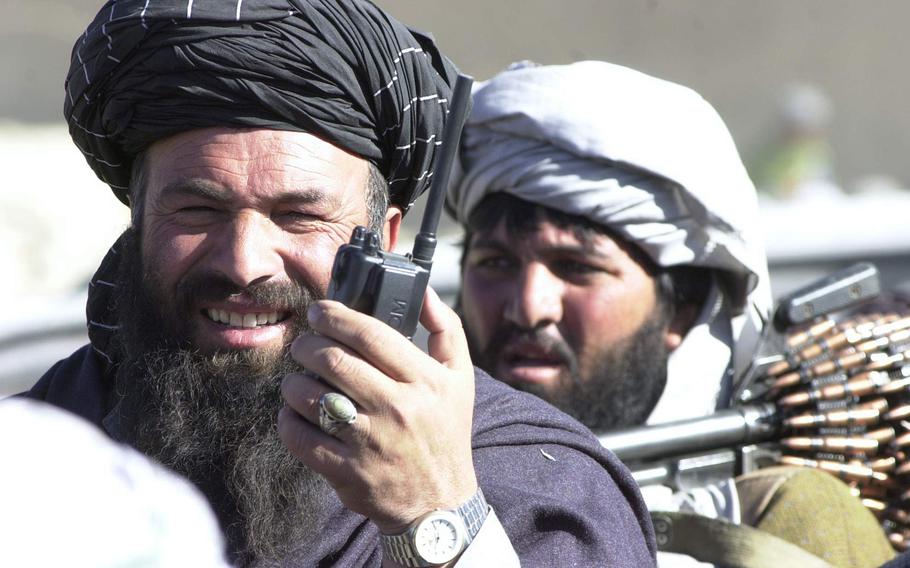
Haji Ghul Mohammed, commander of a group of Taliban soldiers just south of Kabul, makes the final coordination for the surrender of his forces Sunday morning, Nov. 25, 2001. (Jon R. Anderson/Stars and Stripes)
This article first appeared in the Stars and Stripes Pacific edition, Nov. 26, 2001. It is republished unedited in its original form.
Jalreez, Afghanistan — At first light Sunday morning, shivering soldiers at a Northern Alliance checkpoint outside the Taliban- controlled village of Jalreez say it is too dangerous to go any farther.
This is the last pocket of Taliban forces near the capital city of Kabul and for days now it has been the scene of fierce on-again, off-again fighting. Now, say the soldiers huddling around the embers of a dying fire, the battle is over. In a country that has been wracked with civil war for more than 20 years, battles can end abruptly, allegiances can suddenly shift and — in this case, especially — victories are not always complete.
The Taliban troops have surrendered, say the Northern Alliance soldiers, but they refuse to give up their weapons. More important to U.S. military terrorist hunters, most of the fighters — many of them Arabs and Pakistanis loyal to Osama bin Laden—have already fled through the dusty, barren mountains out of the village south to the Taliban stronghold of Kandahar.
The only remaining fighters — about 200 troops in all — are from the small war-ravaged village and say they must have a way to protect themselves from rival clans nearby.
Near a main juncture leading from Kabul to Kandahar and a main road running west to the key city of Herat, the pocket of resistance has been a thorn in the side of the Northern Alliance’s battle plans to seize the rest of Afghanistan.
Effectively blocking Northern Alliance troops from advancing en masse to Kandahar from Kabul, the Taliban forces here have put up grudging resistance since the pro-bin Laden regime fled Kabul under the weight of U.S. airstrikes.
Trading artillery and heavy machine gun fire, and racking up more than a dozen dead and wounded between the two sides, the battle to control a patch of mountainous desert is as much about clearing out the last remnants of the old regime around Kabul as it is preparing the way for the next offensive south into Kandahar. A final offensive aimed at erasing the Taliban completely from the map of Afghanistan, and setting the stage for U.S. forces to begin a determined hunt for bin Laden and his network of fighters now believed to be in hiding in Afghanistan’s remote, rugged mountains.
As the morning sun climbed above Jalreez to high noon, the end came quickly.
With trucks packed full of Northern Alliance fighters suddenly rushing into the village, a truce had clearly been reached.
Taliban troops watched from housetops and roadside positions, many casually holding assault rifles and machine guns over their shoulders as if they were weekend hunters watching a parade roll by.
Some even offered friendly waves, trading the Muslim greeting “Salem allay-khum” — “peace unto you” — as the two opposing sides came together at an old schoolhouse to discuss the final terms of surrender.
Others, however, were grim faced, holding their weapons as if they were prepared to return to fighting as quickly as they had stopped.
“Stay calm,” the barrel-chested local Taliban warlord Haji Ghul Mohammed told his commanders over a hand-held radio as the Northern Alliance forces rolled in. “There should be no more conflict.”
Mohammed said all of the “real” Taliban forces had left. His 200 troops, all from this village, were now prepared to join the Northern Alliance.
The surrender terms, he said, would allow his militia to keep their small arms and — upon demand from the Northern Alliance’s high command — he would hand over his heavy weapons, which include rocket launchers and 82mm mortars. “We will hand them over if the government in Kabul needs them,” he said.
That didn’t appear to be happening any time soon, however.
Asked if he trusted his new allies, one Northern Alliance platoon leader shrugged his shoulders, saying “why not?” Because they were so far south — and consequently removed from the protective ranges of the Hindu Cush that allowed the Northern Alliance to keep the Taliban at bay during six years of fighting — this village had no choice but join with the Taliban regime, the platoon leader said.
“We can trust them now, because they still have no choice.”